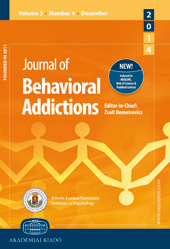A clinical evaluation of the DSM-5 criteria for Internet Gaming Disorder and a pilot study on their applicability to further Internet-related disorders
A clinical evaluation of the DSM-5 criteria for Internet Gaming Disorder and a pilot study on their applicability to further Internet-related disorders
Author(s): Kai W. Müller, Manfred E. Beutel, Michael Dreier, Klaus WölflingSubject(s): Behaviorism
Published by: Akadémiai Kiadó
Keywords: clinical validity; diagnostic accuracy; DSM-5; Internet addiction; Internet Gaming Disorder; Internet-related disorders
Summary/Abstract: Background and aims. Internet Gaming Disorder (IGD) and other Internet-related disorders (IRDs) have become growing health concerns in our today’s lives. Based on defined diagnostic criteria, IGD has been recognized as a condition for further research in the DSM-5; however, other IRDs have been excluded. Since the release of the DSM-5, representativeness and appropriateness of the nine diagnostic criteria have been debated. Although some first evidence has been published to evaluate these criteria, our knowledge is still limited. Thus, the purpose of this study was to provide data on the clinical validity of the DSM-5 criteria for IGD and other types of IRD. We were also interested in examining the additional diagnostic validity of craving that is currently not being considered in the DSM-5. Methods. Analyses on a sample of n = 166 treatment seekers for IRDs were performed. The clinician’s diagnosis was used as a main reference for determining the DSM criteria’s diagnostic performance. Secondary criteria (depression and anxiety) were defined as indicators for the construct validity. Results. The overall diagnostic accuracy ranged between 76.6% for deceiving and 92% for loss of control and craving. Considerable differences occurred in the degree of sensitivity and specificity between the single criteria. No particular differences were found for the applicability of the criteria to other forms of IRDs. Discussion and conclusions. Our results confirm the validity of the DSM criteria. However, the diagnostic utility of the criterion escaping aversive moods is critically discussed. Considering craving as an additional diagnostic indicator might be recommendable.
Journal: Journal of Behavioral Addictions
- Issue Year: 8/2019
- Issue No: 1
- Page Range: 16-24
- Page Count: 9
- Language: English

